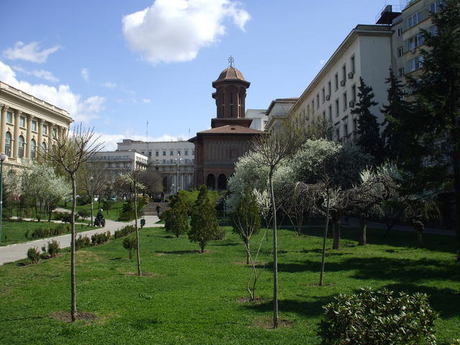Kretzulescu Church
Nestled amid the other historical buildings in Piata Revolutiei, this small red-brick Orthodox church was built in 1722 by the great chancellor Iordache Kretzulescu and his wife, Safta (a daughter of Constantin Brancoveanu) in the Brancovenesti architectural style. The interior frescoes were executed around 1860 by the famous Romanian painter Gheorghe Tattarescu.
Kretzulescu Church (Romanian: Biserica Kretzulescu or Creţulescu) is an Eastern Orthodox church in central Bucharest, Romania. Built in the Brâncovenesc style, it is located on Calea Victoriei, nr. 45A, at one of the corners of Revolution Square, next to the former Royal Palace.
The church was commissioned in 1720–1722 by the boyar Iordache Creţulescu and his wife Safta, a daughter of prince Constantin Brâncoveanu. Originally, the exterior was painted, but since the restoration work done in 1935–1936 (under the supervision of architect Ştefan Balş), the facade is made of brick. The frescoes on the porch date from the original structure, while the interior frescoes were painted by Gheorghe Tattarescu in 1859–1860.
The church, damaged during the November, 1940 earthquake, was repaired in 1942–1943. In the early days of the communist regime, Kretzulescu Church was slated for demolition, but was saved due to efforts of architects such as Henriette Delavrancea-Gibory. More renovations took place after the Bucharest earthquake of 1977 and the Revolution of 1989. To the side of the church now stands a memorial bust of Corneliu Coposu.
On one of the corners of Piata Revolutiei, next to the former Royal Palace, lies the beautiful red brick Kretzulescu church, one of the oldest churches in Bucharest. It was commisioned in 1722 by the boyar Iordache Kretzulescu and his wife Safta, a daughter of prince Constantin Brancoveanu. The church is built in the style created by Constantin Brancoveanu, a seventeenth century ruler of Wallachia, who commisioned numerous buildings during his reign and set out to create a distinctive national genre of architecture. The Brancovenesc or Brancovean Style blends Byzantine and Western architectural elements together with indigeneous forms. Another fine example of this style is Mogosoaia palace, outside Bucharest. The church suffered damage during the 1989 revolution but was recently restored. The frescoes in the porch are especially beautiful. Inside there still can be seen fragments of the late nineteen century frescoes (1859 - 1860) done by Gheorghe Tattarescu, a great Romanian painter. To the side of the church stands a memorial bust of Corneliu Coposu who spent 17 years in prison for his anti-communist activities and was awarded the Legion d'Honeur by French government. Address: Calea Victoriei 45 A.
Built in the 1720s, this delicate, double-domed, Eastern Orthodox church is dwarfed by the surrounding buildings of Bucharest but nevertheless draws the eye; it’s a vibrantly red brick structure, set at the centre of its own sunken, somewhat dilapidated, tree-lined courtyard, and its Brancovenesc architecture is rather at odds with the rest of Calea Victoriei.
Marked down for demolition during the Communist era and almost destroyed by two separate earthquakes, it was repeatedly and carefully restored and although the painted exterior is no longer visible, some of the original frescoes are still present on the porch ceiling – bright and arrestingly beautiful for all their age – and the wall paintings inside were made in 1860 by Gheorghe Tattarescu (famous in Romania for being at the forefront of the classical revival which took place in Europe towards the end of the 19th century).




